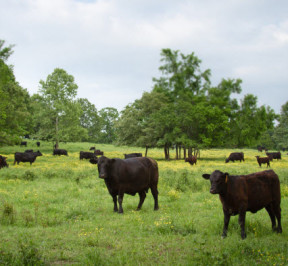Home Page › Halal Meat › Future of the Grassfed Industry in US

Jan 26
Future of the Grassfed Industry in US
We have come a long way, folks! When our farm started marketing grassfed beef directly to customers we had a fairly clear field but not a lot of understanding of what the term grassfed meant. Our biggest challenge was trying to explain one-on-one to customers what grassfed was and how it represented a different production model.
Today, the grassfed message is more readily understood by consumers and has become a real buzz word with media, consumers, food service, and retailers. This still emerging industry now faces a whole new set of challenges. The good news is that grassfed has come into its own and is accepted as a real and viable alternative. The bad news is that grassfed has come into its own and faces some mountainous new challenges.
Over the last decade the grassfed industry has experienced incredible growth. Beginning as a small niche with less than 3% of the market each year has shown a 20-30% growth increase in that market. Increasing consumer demand, as a part of the larger food movement, has driven this growth. Much of this information is antidotal in that the USDA has just begun to tract grassfed production. But it safe to say that grassfed has indeed gone mainstream. As consumer demand continues to increase the challenge of supply is being met in various ways. I think we will see continued large growth over the next 3-5 years and that after that time we may begin to see it plateau as supply increases to meet demand. It is here that our new challenges in grassfed begin.
It is good that American cattlemen are stepping up to embrace or at least explore grassfed production models. Many are seriously looking at what it will take to transition from conventional to a pasture based system. This increase in production will allow an increase in supply as we go forward. Part of this is due to opportunity (and high corn prices) but part is due to producers who view grassfed as better stewardship of the land, better transparency and relationship with the customer and better support for the American farmer. The characteristics of raising a product that is healthier, uses a solar energy model that is better for the land, embraces high animal welfare, uses no antibiotics, no growth hormones. These attributes are important to many consumers today and are embraced by more and more producers. This is wonderful.
America is in the midst of a food movement and is no longer willing to place absolute trust in the industrial food giants who at all costs were determined to create cheaper food but paid little attention to the significant costs not so easily seen. That bubble burst when in the mid-nineties kids died from eating fast food contaminated with E.coli 0157.H7. American began to look at their food system and many became increasingly alarmed by what they saw as the layers were peeled back. Food as health, life and culture has begun to focus the public eye on how we approach this fundamental need. Many of us just did not like or trust what had become of our food system through the hands of industry.
Food has become a more political topic as the true costs of cheap food became known and people began to call for a change. The costs to the environment, to animal welfare, and public health were too high. It became apparent that the industrial model was itself not sustainable. As put by the recent AGA conference, “Growing a culture of simple, honest food.”
As such, grassfed is not just that an animal is fed a forage diet it was intended by nature to consume. Rather, grassfed embodies a big tent and represents movements of animal welfare, sustainable agricultural practices, healthier and safer food, more environmentally friendly practices, local production, antibiotic resistance and support of smaller-scale family farms. Grassfed places how America sources protein right smack in the middle of the food movement. Consumers today are seeking a relationship with the food they eat. They have become savvy enough to want to know who produces it, where it is produced and how it is produced. In short, they want transparency each step of the way. These groups have their sights on changing the face of American food system.
So, what about continued growth in the grassfed industry and why will it plateau? I would expect a slowing of growth or a plateau as supply begins to level out with demand. That is not of concern to many of us who have been grassfed for quite some time but the issue shifts to what kind of grassfed?
In this current situation of high demand for available supply, Big Ag is moving quickly to take opportunity and get their share of the American pie. A niche market that commands a greater margin and over time becomes stable in name and continues to grow catches attention of the big guys. Grassfed, no longer flying under the radar, sticks its toe out into the Big Ag world and there are a lot of wolves out there.

First, you are beginning to see the industrial version of grassfed. I define that to be the situation where animals legally meet the grassfed claim as held by the USDA (addresses the feeding practice alone) but are raised under the industrial model. This method is fossil fuel laden and disingenuous to consumers who envision a more pastoral setting. Industrial grassfed is raised in feedlots, fed antibiotics and given growth hormones. It enjoys the benefits of economy of scale and integration shared with their conventional counterparts. This is not necessarily bad unless you share the idea that the attributes of grassfed embody the goals and vision of the food movement. Claims that have to do with animal welfare, raising an animal in a behaviorally and biologically appropriate manner, the environment, support of American family farms and transparency along with the value of local production that builds stronger rural communities. Yet, Big Ag is really good at spin and use the same buzz words we use. They make it hard to determine the truth of production. That can get in the way of transparency and the simplicity of a farm to table food movement.

The second threat is the increase of supply from off shore grassfed. Shipped half way around the world to supply American demand and market, many Big Ag companies are boosting the emergence of grassfed into mainstream by imports from Australia and Uruguay. Raised under unknown conditions and standards contrasts the call for transparency, local production and supporting American farmers.
Our challenge now is to keep grassfed real. The Amarican Grassfed Association tag line that says, “Not just grassfed but AGA grassfed” needs to be our message directly to the consumer who is part of the food movement and wants to see food system reform in this country and the world. Keeping a transparent path from producer to processor to distributor to the end user. You can join this challenge by supporting the AGA logo applied to certified grassfed producers who meet the AGA Grassfed Ruminant Standards. If consumers recognize the label and understand what it means we will have come a long way to keep grassfed real.






